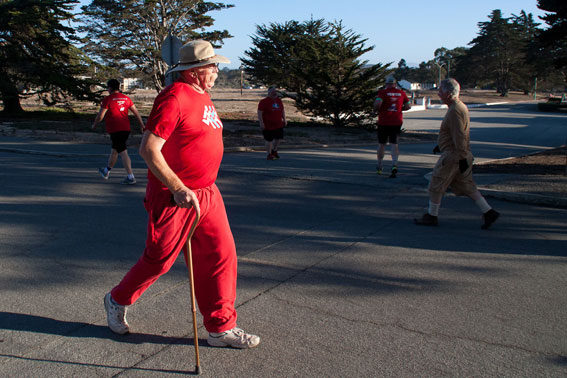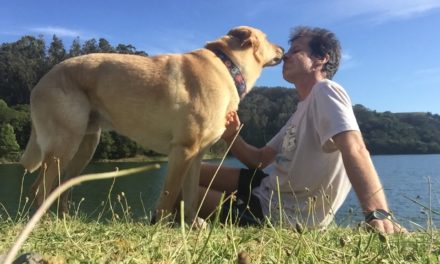- California Enduro Series Announces 2024 Schedule - 11/19/2023
- ASHLAND MOUNTAIN CHALLENGE 2023 – CES RACE REPORT - 10/04/2023
- China Peak Enduro 2023 – CES Race Report - 09/04/2023
Fleet Feet program offers veterans a running chance for a new life
By Laura Chiorello
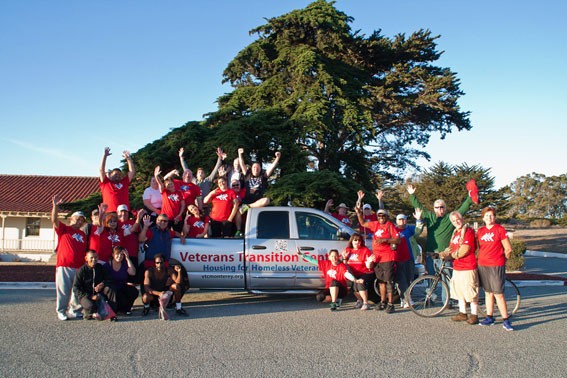
The very first group of veterans and Monterey VTC staff members to participate in a No Boundaries program provided by Fleet Feet Monterey this past fall. The second session begins this month.
The weather is unusually dreadful early one Saturday morning at the former Fort Ord in Marina, California. For the first time in months, it’s raining real rain, and the gloom hangs over the parking lot like a thick blanket. Yet the mood among the arriving homeless veterans is light, even jovial. One by one, they show up, cheerfully greeting one another in bright red technical shirts, sweat pants, baseball caps, new running shoes, and slickers. Light banter recedes to quiet dynamic stretching as they stand in a wide circle in the parking lot. Today they will be going farther than they ever have, and they are eager to begin.
This scene of runners gathering at an obscenely early hour on the weekend may be a common event, but this is no ordinary running group. These are veterans of the Veterans Transition Center Monterey (VTC). They are currently living in transitional housing and receiving a variety of specialized services to help them obtain permanent housing and employment. They also happen to be the first group of veterans to participate in a voluntary run/walk program offered through the VTC by Fleet Feet Monterey, a local running store. Their journey training together for a 5K on Thanksgiving Day underscores the challenges of ending veteran homelessness—and reveals how a structured exercise program may be part of the solution.
About thirty men and women stream out of the parking lot and hook right to begin the 2.5-mile trek over the wet roads that wind up and down past chain link fences and abandoned buildings. Many are male veterans of the Vietnam era, but there are also a few younger men and women. One couple walks with their preschool daughter, who rides her scooter alongside them. In the middle of the group, Bill, an Air Force veteran, walks briskly. He arrived at the VTC in December 2013 after his release from Soledad State prison, where he suffered debilitating arthritis. Now, he says that his pain is manageable, even as he manages the center’s organic garden and participates in longer workouts. Bill says with a slight smile, “I like the hills.” He even wants to run a race someday. But most importantly, he tells me, “I feel good about myself.”
Tina Coillot, who co-owns Fleet Feet stores in Monterey and Aptos with her husband, Russ, is thrilled by the progress the veterans have made in a short time. A former mental health social worker who also comes from a military family, Coillot is well aware of the challenges that veterans face, and wanted to help. “I feel like it’s a way that we can give back to an underserved community, our veterans. It’s something that could be potentially transformational.”
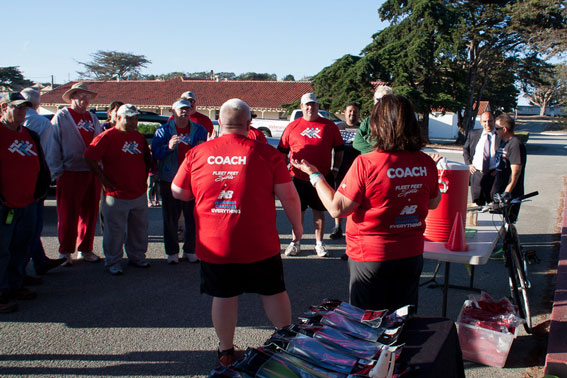
Russ and Tina Coillot, co-owners of Fleet Feet Aptos and Monterey, address the veterans before a Tuesday evening workout.
From the outside, Martinez Hall, the one-story building housing the VTC, is non-assuming, surrounded by quiet roads and cypress trees. However, the program that it offers is at the forefront of the nation’s battle to end veteran homelessness. In 2010 the federal government set a goal that all veterans will be in safe and secure housing by 2015. Bipartisan support has kept the issue a high priority, and millions of dollars have been poured into service centers helping homeless veterans in their communities. The VTC’s transitional housing model, “Coming Home,” offers long-term rehabilitation and self sufficiency for veterans, which are key parts of the VA’s strategy to reach its goal.
“The beauty of our program is that we can immediately put them in housing with fellow veterans,” says William “Terry” Bare, the executive director of the VTC.
Twenty previously abandoned houses on the former Fort Ord have been renovated, providing shared housing for the fifty-six veterans the program serves; twenty more houses await funding. In addition to housing, each veteran is provided with a customized program to meet his or her needs, such as food, clothing, transportation, and counseling. The center is also unique in that it provides shelter for families as well as single men and women, thanks to what he calls a “robust donation system” from the surrounding community.
Bare participates in every workout with the veterans. Athletic and trim, he runs in the light rain at the front of the pack and could easily pass as a coach. He is modest about his fitness, but doesn’t mince words when describing the achievements of the VTC. He proudly tells me the center boasts a 93 percent success rate in its alumni staying sober, housed, and employed one year after leaving their program. He notes that according to an internal VA audit, the VTC is ranked as one of the best in the nation for its type of program.
Despite the center’s success, Bare is keenly aware there are more veterans who need help from the VTC. While nationwide there has been a steep decline in veteran homelessness (down 33 percent since 2010, according to an August 2014 report from the U.S. Department of Housing and Urban Development, or HUD), California retains the highest population of homeless veterans in the nation, approximately 15,179, according to 2013 data from HUD. The VTC estimates the homeless population in Monterey county—which, despite the closure of Fort Ord in 1994, maintains a significant military community with the presence of the Presidio of Monterey, the Naval Postgraduate School, the California Army National Guard, and the operation of the base exchange—to be around 1,000.
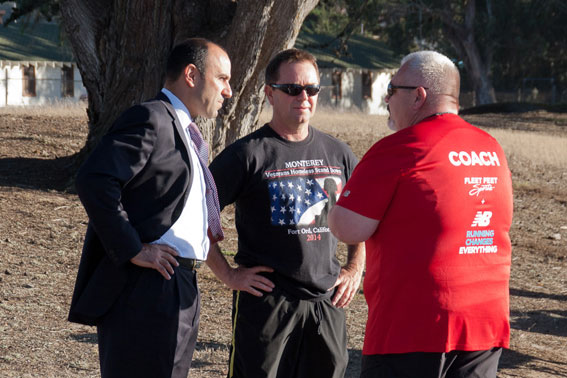
Russ talks with Jimmie Panetta, VTC board member (and son of Leon Panetta) and Terry Bare, executive director of the VTC.
There are complex reasons why veterans become homeless—and tend to stay homeless longer than those from the general population. Historically, the main causes have included physical disabilities, mental trauma, economic hardships, and addiction issues. However, among the 2.5 million men and women who have served in Afghanistan and Iraq, there are higher percentages suffering post-traumatic stress, traumatic brain injuries, and sexual trauma. The VA recently estimated that up to 50,000 of these younger veterans are either homeless or at risk of becoming homeless, and service centers are adapting to meet their unique needs.
Evidence that regular exercise improves physical fitness and mood is growing, but incorporating a structured training program as part of therapy is still unusual. “We are not necessarily a nation that looks at wellness. We tend to address acute issues,” says Blayne Smith, executive director of Team Red White and Blue, a nationwide non-profit that promotes group training for local races as a way for veterans to improve their health and connect to their communities. “There are four ways (a training program) really helps. It improves your physical health and that’s important. It’s pretty well documented that exercise helps with mental health. There’s a certain amount of goal orientation that is really attractive for veterans. Training for a specific race or event gives you a goal, which is very important. And it’s a great way to make friendships.”
Bare wanted to provide such an experience for the veterans at the VTC when he created “Vet-Fit,” the nutrition and exercise component of his center’s program. He was in the process of developing the physical fitness portion of his plan when Fleet Feet’s Coillot approached him and offered a “No Boundaries” program for the veterans. When he learned what it entailed, he remembers feeling “ecstatic.”
“No Boundaries” is a nationwide program created in 2006 by Fleet Feet Incorporated to train previously sedentary people for a 5K in a group setting over a 12-week period. Although it is implemented in nearly all of Fleet Feet’s 131 franchise stores, this is the first time a training group has been created just for veterans, according to Jillian Wiederer, a brand manager at Fleet Feet Incorporated who oversees the No Boundaries program.
Interested participants had health screenings before beginning the program, and since they are in a clean and sober program, they must submit to random drug testing throughout the training. In addition to Bare and the veterans, a few staff members also participate in the workouts. Bare says of the collaboration with Fleet Feet Monterey, “What they are doing is a force multiplier for the rehabilitation of our vets.”
On Tuesday evenings and Saturday mornings, the veterans arrive at the center to complete their workouts. They have learned about the differences between dynamic and static stretching, the benefits of proper pacing, and mental strategies for tackling longer distances. At the first workout, some showed up in boots and jeans. A few weeks later, thanks to the generous support from New Balance, all participants have “No Boundaries” technical shirts and new running shoes. Superfeet sent a representative to one of the workouts who personally fit every participant with shoe inserts. The entire program has been offered for free to the VTC.
Joy Marquez, who coaches the Saturday workouts, is a Navy veteran and doctoral student in clinical psychology linked with sport psychology at John F. Kennedy University. “In the military it’s very much about staying together, accomplishing a mission together, in a way that’s so intertwined,” she says. “Something that we had to switch for them was that it was ok to be an individual. You weren’t slowing everyone down because of your ability. That what they were doing was good enough. That what they could give was all they needed to give.”
One of the first to arrive back at the parking lot is Kherry, an army veteran who enjoys chatting with everyone and wears a constant smile on his face. “I think what’s new for me with Fleet Feet is social running and making friends, getting tips about running. All the coaches are so supportive.” He is proud that he is losing weight. “I feel leaner. I’m a little more confident in small ways, like being able to walk up to people and not be afraid of being judged.”
Kherry’s story is not unusual. Upon entering civilian life, many veterans become sedentary. Statistics from the VA reveal that 7 out of 10 veterans receiving VA care are either overweight or obese. Geno, an Air Force veteran, has been steadily losing weight since before starting “No Boundaries.” His red technical shirt hangs loosely off his tall shoulders as he talks modestly about losing 97 pounds. A recovering alcohol and food addict, Geno credits the support he has received from Food Addicts Anonymous and the VTC for his success and he hopes to stay active. “I’d like to do the ‘Honor Our Fallen’ 10K next year. I saw them (the runners and walkers) do that when we volunteered this year, and I’d like to do it.”
Many of the veterans want to continue the training program and Coillot is investigating long-term sources of funding. “We need to broaden our ability to do good,” she says emphatically. She is introducing an “Adopt an Athlete” program, in which members of the public can sponsor an athlete in one of Fleet Feet’s training programs, and she is applying for grants. No matter what, Coillot and Bare intend to maintain their collaboration.
Bare says that “No Boundaries” has become an essential part of the VTC’s services. He notes the training appeals to older veterans, who enjoy the camaraderie of their fellow veterans, and to the new generation of veterans, who are often looking for ways to integrate within their communities. “It builds self confidence and self-esteem. It impacts the rest of their lives.”
After the soggy Saturday morning workout comes to an end, Charles, an army veteran, waits patiently under the eaves as the light rain fades and the morning sun starts streaming through the clouds. He has just slowly jogged the entire distance with perfect form, and he reveals that he is battling Parkinson’s Disease. “It’s a real personal challenge,” he says of being in the program. “You have to develop a consistent mindset to continue this level of exercise because it is a mindset, and I’ve never had this mindset before.”
For more information on the VTC or how to help, see www.vtcmonterey.org, or call 1-831-883-VETS



